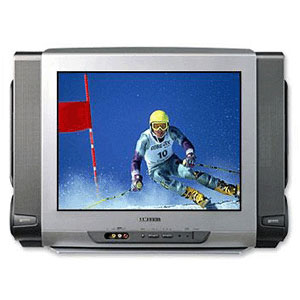Login form
Television
 Television, system of sending and receiving pictures and sound by means of electronic signals transmitted through wires and optical fibers or by electromagnetic radiation. These signals are usually broadcast from a central source, a television station, to reception devices such as television sets in homes or relay stations such as those used by cable television service providers.
Television, system of sending and receiving pictures and sound by means of electronic signals transmitted through wires and optical fibers or by electromagnetic radiation. These signals are usually broadcast from a central source, a television station, to reception devices such as television sets in homes or relay stations such as those used by cable television service providers.
Television is the most widespread form of communication in the world. Though most people will never meet the leader of a country, travel to the moon, or participate in a war, they can observe these experiences through the images on their television.
Television has a variety of applications in society, business, and science. The most common use of television is as a source of information and entertainment for viewers in their homes. Security personnel also use televisions to monitor buildings, manufacturing plants, and numerous public facilities. Public utility employees use television to monitor the condition of an underground sewer line, using a camera attached to a robot arm or remote-control vehicle. Doctors can probe the interior of a human body with a microscopic television camera without having to conduct major surgery on the patient. Educators use television to reach students throughout the world.
People in the United States have the most television sets per person of any country, with 835 sets per 1,000 people as of 2000. Canadians possessed 710 sets per 1,000 people during the same year. Japan, Germany, Denmark, and Finland follow North America in the number of sets per person.
The scientific principles on which television is based were discovered in the course of basic research. Only much later were these concepts applied to television as it is known today. The first practical television system began operating in the 1940s.
In 1873 the Scottish scientist James Clerk Maxwell predicted the existence of the electromagnetic waves that make it possible to transmit ordinary television broadcasts. Also in 1873 the English scientist Willoughby Smith and his assistant Joseph May noticed that the electrical conductivity of the element selenium changes when light falls on it. This property, known as photoconductivity, is used in the vidicon television camera tube.
In 1888 the German physicist Wilhelm Hallwachs noticed that certain substances emit electrons when exposed to light. This effect, called photoemission, was applied to the image-orthicon television camera tube.Although several methods of changing light into electric current were discovered, it was some time before the methods were applied to the construction of a television system. The main problem was that the currents produced were weak and no effective method of amplifying them was known. Then, in 1906, the American engineer Lee De Forest patented the triode vacuum tube. By 1920 the tube had been improved to the point where it could be used to amplify electric currents for television.
A television program is created by focusing a television camera on a scene. The camera changes light from the scene into an electric signal, called the video signal, which varies depending on the strength, or brightness, of light received from each part of the scene. In color television, the camera produces an electric signal that varies depending on the strength of each color of light.
Three or four cameras are typically used to produce a television program (see Television Production). The video signals from the cameras are processed in a control room, then combined with video signals from other cameras and sources, such as videotape recorders, to provide the variety of images and special effects seen during a television program.
Audio signals from microphones placed in or near the scene also flow to the control room, where they are amplified and combined. Except in the case of live broadcasts (such as news and sports programs) the video and audio signals are recorded on tape and edited, assembled with the use of computers into the final program, and broadcast later. In a typical television station, the signals from live and recorded features, including commercials, are put together in a master control room to provide the station's continuous broadcast schedule. Throughout the broadcast day, computers start and stop videotape machines and other program sources, and switch the various audio and visual signals. The signals are then sent to the transmitter.
The transmitter amplifies the video and audio signals, and uses the electronic signals to modulate, or vary, carrier waves (oscillating electric currents that carry information). The carrier waves are combined (diplexed), then sent to the transmitting antenna, usually placed on the tallest available structure in a given broadcast area. In the antenna, the oscillations of the carrier waves generate electromagnetic waves of energy that radiate horizontally throughout the atmosphere.
The waves excite weak electric currents in all television-receiving antennas within range. These currents have the characteristics of the original picture and sound currents. The currents flow from the antenna attached to the television into the television receiver, where they are electronically separated into audio and video signals. These signals are amplified and sent to the picture tube and the speakers, where they produce the picture and sound portions of the program.

